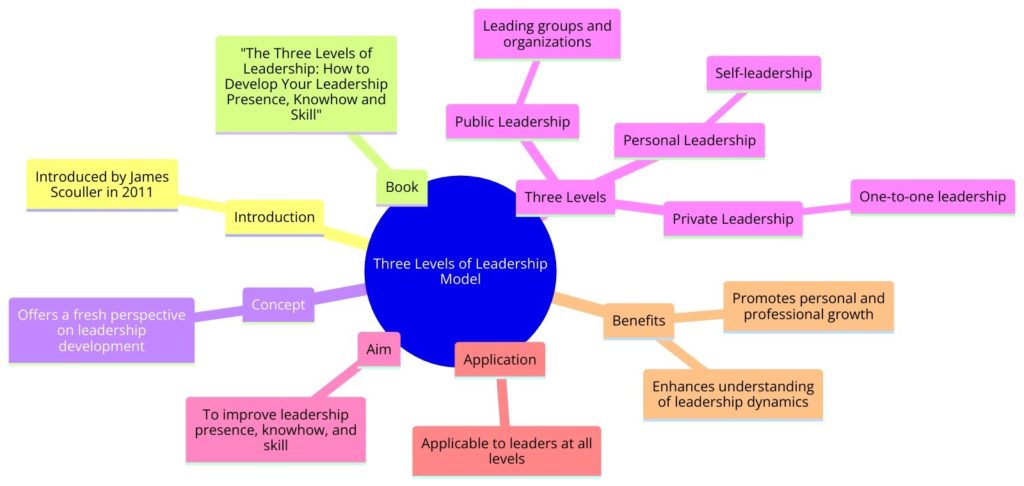Three Levels of Leadership Model
James Scouller’s Three Levels of Leadership Model, introduced in his book “The Three Levels of Leadership: How to Develop Your Leadership Presence, Knowhow, and Skill,” published in 2011, offers a fresh perspective on leadership development. Scouller, an executive coach and leadership expert, proposes that effective leadership is rooted in personal development and the ability to manage oneself and influence others. His model is distinct in its comprehensive approach, integrating personal mastery with practical leadership skills, thus addressing both the inner and outer game of leadership.
What is the Three Levels of Leadership Model?
Scouller’s model suggests that leadership operates on three interconnected levels:
- Public Leadership: Refers to the behaviors that leaders exhibit in a group context. It involves the traditional tasks of leadership, such as setting direction, creating structures, and inspiring the team. Public leadership focuses on the skills needed to influence a group toward achieving its objectives.
- Private Leadership: Involves one-on-one interactions between the leader and individual team members. It’s about coaching, supporting, and developing each member of the team to bring out their best. Private leadership emphasizes the importance of building strong, trusting relationships on an individual level.
- Personal Leadership: The foundational level of the model, personal leadership, is about self-awareness, self-management, and personal growth. It encompasses the leader’s character, beliefs, and emotional intelligence. Scouller argues that personal leadership is critical because the leader’s inner world drives their ability to lead effectively in public and private contexts.
Why It Is Valuable
The Three Levels of Leadership Model provides several key benefits:
- Holistic Approach: By addressing leadership from personal, one-on-one, and group perspectives, the model offers a comprehensive framework for leadership development.
- Emphasis on Self-awareness: The focus on personal leadership underscores the importance of self-awareness and emotional intelligence in effective leadership, promoting continuous personal development.
- Adaptability: The model recognizes that different situations may require different leadership approaches and that leaders must be adaptable in their strategies.
- Improvement in Relationships: The emphasis on private leadership highlights the value of individual relationships within a team, encouraging leaders to invest in the personal and professional development of their team members.
When and How to Use It
Leaders can apply Scouller’s Three Levels of Leadership Model in various contexts, including team management, organizational change, and personal leadership development. To use the model effectively:
- Engage in regular self-reflection and seek feedback to enhance self-awareness and emotional intelligence.
- Tailor leadership approaches to suit the needs of individual team members, recognizing that each may require different support and guidance.
- Focus on developing leadership behaviors that inspire and mobilize groups toward shared goals.
- Pursue continuous personal development to overcome psychological barriers to effective leadership and to model lifelong learning for the team.
Shortcomings/Criticisms
While Scouller’s model is praised for its holistic approach, it is not without its criticisms:
- Complexity in Application: Some may find the model challenging to apply, given its emphasis on internal psychological work alongside traditional leadership tasks.
- Insufficient Detail on Skill Development: Critics argue that the model could provide more concrete guidance on developing specific leadership skills, particularly at the public and private levels.
- Overemphasis on the Leader: The focus on personal development might overlook the importance of systemic factors and organizational culture in shaping leadership effectiveness.
James Scouller’s Three Levels of Leadership Model offers a unique and comprehensive framework for understanding and developing effective leadership. By emphasizing the interconnectedness of personal development, interpersonal relationships, and group dynamics, the model encourages leaders to cultivate a deep understanding of themselves and their impact on others. Despite some challenges in its application, the model’s holistic perspective provides valuable insights for those seeking to enhance their leadership presence, knowhow, and skill.


